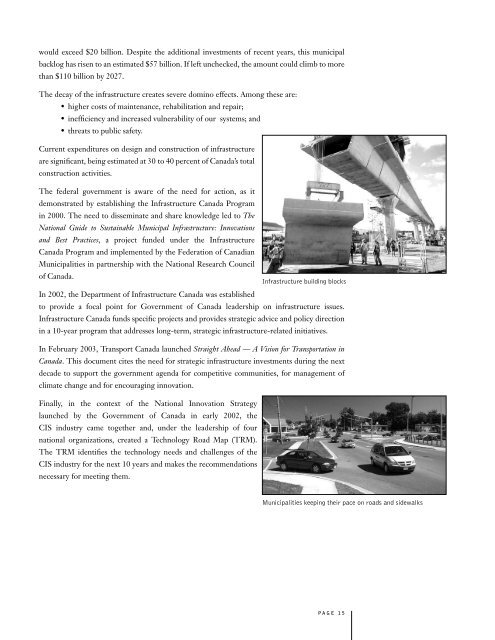Civil Infrastructure Systems Technology Road Map - Engineers ...
Civil Infrastructure Systems Technology Road Map - Engineers ...
Civil Infrastructure Systems Technology Road Map - Engineers ...
- No tags were found...
You also want an ePaper? Increase the reach of your titles
YUMPU automatically turns print PDFs into web optimized ePapers that Google loves.
would exceed $20 billion. Despite the additional investments of recent years, this municipalbacklog has risen to an estimated $57 billion. If left unchecked, the amount could climb to morethan $110 billion by 2027.The decay of the infrastructure creates severe domino effects. Among these are:• higher costs of maintenance, rehabilitation and repair;• inefficiency and increased vulnerability of our systems; and• threats to public safety.Current expenditures on design and construction of infrastructureare significant, being estimated at 30 to 40 percent of Canada’s totalconstruction activities.The federal government is aware of the need for action, as itdemonstrated by establishing the <strong>Infrastructure</strong> Canada Programin 2000. The need to disseminate and share knowledge led to TheNational Guide to Sustainable Municipal <strong>Infrastructure</strong>: Innovationsand Best Practices, a project funded under the <strong>Infrastructure</strong>Canada Program and implemented by the Federation of CanadianMunicipalities in partnership with the National Research Councilof Canada.<strong>Infrastructure</strong> building blocksIn 2002, the Department of <strong>Infrastructure</strong> Canada was establishedto provide a focal point for Government of Canada leadership on infrastructure issues.<strong>Infrastructure</strong> Canada funds specific projects and provides strategic advice and policy directionin a 10-year program that addresses long-term, strategic infrastructure-related initiatives.In February 2003, Transport Canada launched Straight Ahead — A Vision for Transportation inCanada. This document cites the need for strategic infrastructure investments during the nextdecade to support the government agenda for competitive communities, for management ofclimate change and for encouraging innovation.Finally, in the context of the National Innovation Strategylaunched by the Government of Canada in early 2002, theCIS industry came together and, under the leadership of fournational organizations, created a <strong>Technology</strong> <strong>Road</strong> <strong>Map</strong> (TRM).The TRM identifies the technology needs and challenges of theCIS industry for the next 10 years and makes the recommendationsnecessary for meeting them.Municipalities keeping their pace on roads and sidewalksP A G E 1 5










